Check Lancia Thesis 2007 Owner handbook (in English)
[x] Cancel search | Manufacturer: LANCIA, Model Year: 2007, Model line: Thesis, Model: Lancia Thesis 2007Pages: 386, PDF Size: 8.69 MB
Page 290 of 386

289
A- Central ceiling light bulb.
B- Courtesy light bulbs.
3) Remove clipped in glass bulbs
from the bulb holders and replace
them.
4) Insert the bulb holders and turn
them clockwise.
5) Refit the ceiling light by insert-
ing first the rear part and then
pressing the front part until it fits.
IMPORTANTWhen refitting the
ceiling light check that the electrical
wires are positioned correctly.GLOVE COMPARTMENT LIGHT
To replace the bulb:
1) Remove the lens by using a
screwdriver as a lever on clip A
(fig. 36).2) Press the two sides of shieldB
(fig. 37) at the fastening clips and
turn it.
3) Replace the clipped in bulb C.
4) Close the shield Bby clipping it
into its housing.
5) Refit the lens by inserting side D
(fig. 36) first and then pressing the
other side to engage clip A.
fig. 37
L0A0135b
fig. 36
L0A0134b
fig. 35
L0A0133b
Page 293 of 386

292
IF A FUSE BLOWS
GENERAL (fig. 67)
The fuse is a protective device for
the electric system. It comes into
action (i.e. it cuts off) in the event of
a failure or improper actions on the
electric system.
If an electrical device is not work-
ing, check whether the respective
fuse is blown. The conductor should
not be broken. If it is, replace it with
another with the same amperage
(same colour).A- Undamaged fuse
B- Fuse with broken filament.
Use the tongs Cto extract a fuse to
be replaced. The tongs are to be
found in the main fuse box.
Before changing a fuse,
check the ignition key has
been removed and that all
the other electrical devices have
been switched off.
fig. 67
L0A0127b
Never replace a fuse
with metal wires or any-
thing else. Always use an
intact fuse of the same colour
(same value).
Never change a fuse with
another of higher amper-
age: FIRE RISK!If a general fuse (MIDI-
FUSE or MEGA-FUSE)
blows, do not repair it,
but go to a Lancia Dealership.
If the fuse blows again,
have the car inspected at a
Lancia Dealership.
Page 304 of 386
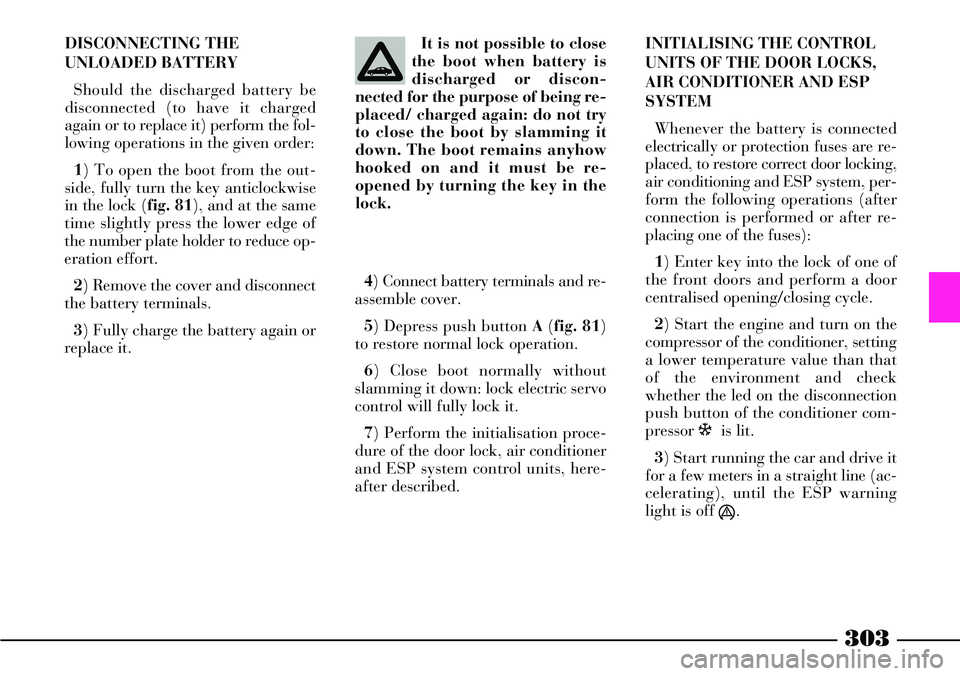
303
DISCONNECTING THE
UNLOADED BATTERY
Should the discharged battery be
disconnected (to have it charged
again or to replace it) perform the fol-
lowing operations in the given order:
1) To open the boot from the out-
side, fully turn the key anticlockwise
in the lock (fig. 81), and at the same
time slightly press the lower edge of
the number plate holder to reduce op-
eration effort.
2) Remove the cover and disconnect
the battery terminals.
3) Fully charge the battery again or
replace it.4) Connect battery terminals and re-
assemble cover.
5) Depress push button A(fig. 81)
to restore normal lock operation.
6) Close boot normally without
slamming it down: lock electric servo
control will fully lock it.
7) Perform the initialisation proce-
dure of the door lock, air conditioner
and ESP system control units, here-
after described.INITIALISING THE CONTROL
UNITS OF THE DOOR LOCKS,
AIR CONDITIONER AND ESP
SYSTEM
Whenever the battery is connected
electrically or protection fuses are re-
placed, to restore correct door locking,
air conditioning and ESP system, per-
form the following operations (after
connection is performed or after re-
placing one of the fuses):
1) Enter key into the lock of one of
the front doors and perform a door
centralised opening/closing cycle.
2) Start the engine and turn on the
compressor of the conditioner, setting
a lower temperature value than that
of the environment and check
whether the led on the disconnection
push button of the conditioner com-
pressor òis lit.
3) Start running the car and drive it
for a few meters in a straight line (ac-
celerating), until the ESP warning
light is off
á. It is not possible to close
the boot when battery is
discharged or discon-
nected for the purpose of being re-
placed/ charged again: do not try
to close the boot by slamming it
down. The boot remains anyhow
hooked on and it must be re-
opened by turning the key in the
lock.
Page 306 of 386

305
Under no circumstances
should a battery charger
be used to start the
engine: it could damage the elec-
tronic systems and in particular
the ignition and injection control
units.Carefully clean the
threading before fastening
the tow ring. Before start-
ing to tow the car, make sure the
ring has been fully fastened. Never try to charge a
frozen battery: first let it
thaw out, otherwise it
may bust. If the battery has
frozen, check that the internal
elements are not broken (risk of
short circuit) and that the casing
is not cracked causing the acid to
leak out. This acid is poisonous
and corrosive.
TOWING THE CAR
The tow ring provided with the car
is to be found in the tool box under
the boot carpet.
To fit the tow ring proceed as fol-
lows:
– Remove the clipped in Acover
from the front (fig. 82) or rear
bumper (fig. 83), by using a screw-
driver as a lever in the point shown
in the figure.IMPORTANT To carry out this
operation, if you use the provided
flat-head screwdriver, cover its head
with a piece of cloth to prevent paint
damaging.
– Screw the tow ring Bin its hous-
ing.
fig. 82
L0A0090b
fig. 83
L0A0091b
Page 307 of 386
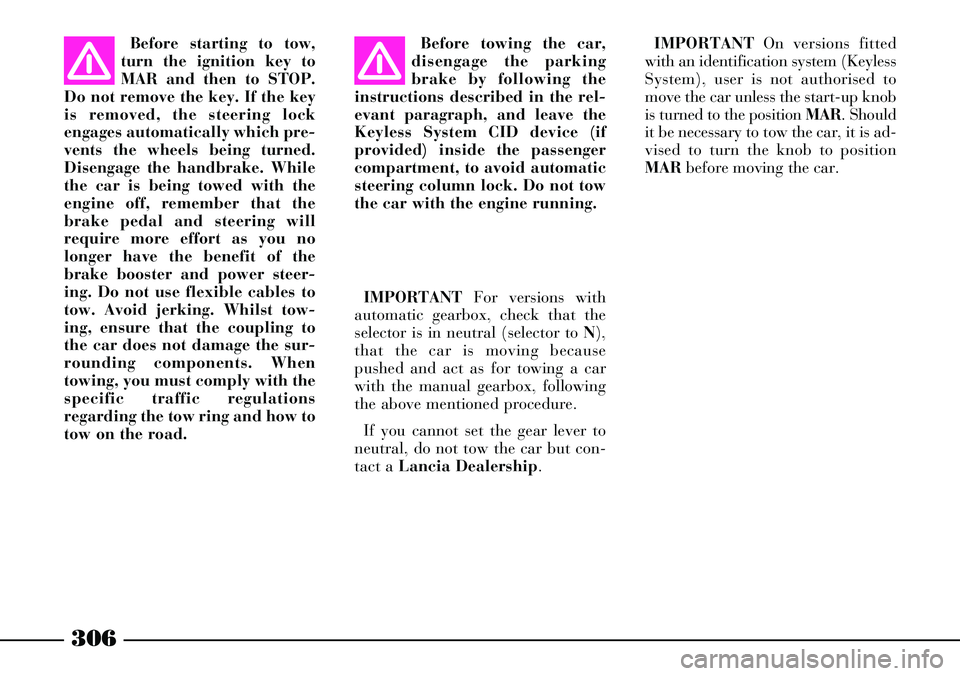
306
Before towing the car,
disengage the parking
brake by following the
instructions described in the rel-
evant paragraph, and leave the
Keyless System CID device (if
provided) inside the passenger
compartment, to avoid automatic
steering column lock. Do not tow
the car with the engine running. Before starting to tow,
turn the ignition key to
MAR and then to STOP.
Do not remove the key. If the key
is removed, the steering lock
engages automatically which pre-
vents the wheels being turned.
Disengage the handbrake. While
the car is being towed with the
engine off, remember that the
brake pedal and steering will
require more effort as you no
longer have the benefit of the
brake booster and power steer-
ing. Do not use flexible cables to
tow. Avoid jerking. Whilst tow-
ing, ensure that the coupling to
the car does not damage the sur-
rounding components. When
towing, you must comply with the
specific traffic regulations
regarding the tow ring and how to
tow on the road.IMPORTANTFor versions with
automatic gearbox, check that the
selector is in neutral (selector to N),
that the car is moving because
pushed and act as for towing a car
with the manual gearbox, following
the above mentioned procedure.
If you cannot set the gear lever to
neutral, do not tow the car but con-
tact a Lancia Dealership.IMPORTANTOn versions fitted
with an identification system (Keyless
System), user is not authorised to
move the car unless the start-up knob
is turned to the position MAR. Should
it be necessary to tow the car, it is ad-
vised to turn the knob to position
MAR before moving the car.
Page 312 of 386
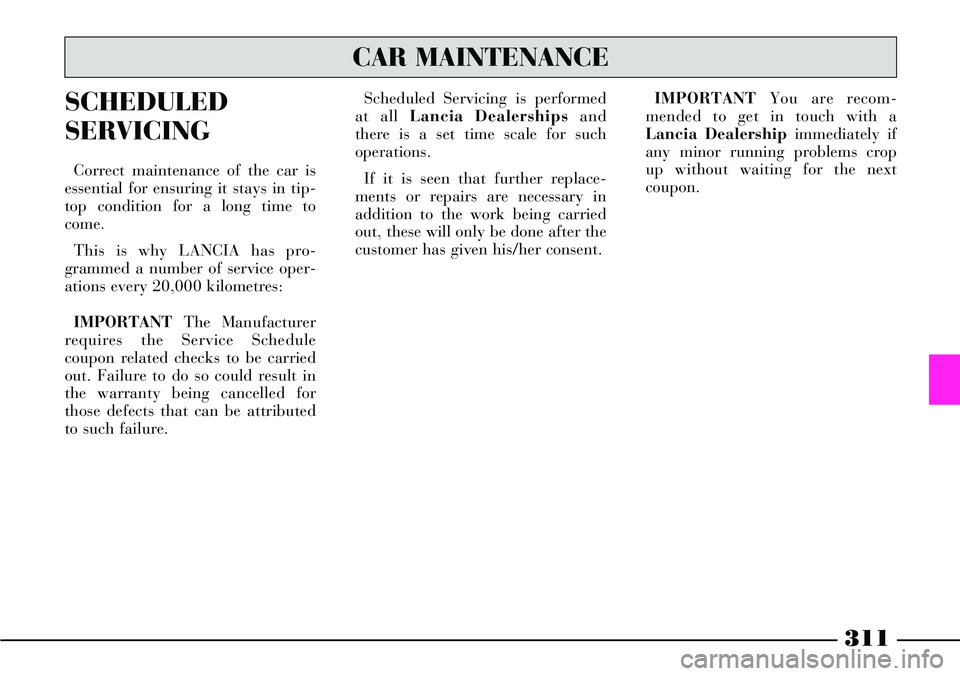
311
SCHEDULED
SERVICING
Correct maintenance of the car is
essential for ensuring it stays in tip-
top condition for a long time to
come.
This is why LANCIA has pro-
grammed a number of service oper-
ations every 20,000 kilometres:
IMPORTANTThe Manufacturer
requires the Service Schedule
coupon related checks to be carried
out. Failure to do so could result in
the warranty being cancelled for
those defects that can be attributed
to such failure.Scheduled Servicing is performed
at all Lancia Dealershipsand
there is a set time scale for such
operations.
If it is seen that further replace-
ments or repairs are necessary in
addition to the work being carried
out, these will only be done after the
customer has given his/her consent.IMPORTANTYou are recom-
mended to get in touch with a
Lancia Dealershipimmediately if
any minor running problems crop
up without waiting for the next
coupon.
CAR MAINTENANCE
Page 313 of 386

312
SERVICE SCHEDULE
20 40 60 80 100 120 140 160 180 thousands of kilometres
ççççç çççç
ççççç çççç
ççççç çççç
çç çç
ççççç çççç
ççççç çççç
çç
çç çç
ççççç çççç
çç
çç çç
ççççç çççç
ççççç ççççCheck tyre conditions and wear; adjust pressure, if required
Check primary and secondary battery charge status
Check wear of windscreen/rear window blades
Check rear disc brake pad wear
Inspect conditions of: underbody protection and outside
bodywork, piping (exhaust - fuel lines - brake lines), rubber parts
(boots, sleeves, bushings, etc.), brake and fuel line hoses
Check for bonnet and boot lock cleanness, lever cleanness
and lubrication
Sight check for conditions of Poly-V accessory drive belt
Check diesel engine smokiness in exhaust
Replace fuel filter (JTD versions)
Check fuel evaporation system operation
Replace air cleaner cartridge (petrol versions)
Replace air cleaner cartridge (JTD versions)
Check and top up fluids (engine coolant, brakes,
hydraulic clutch, power steering, windscreen washer, battery, etc.)
Page 314 of 386
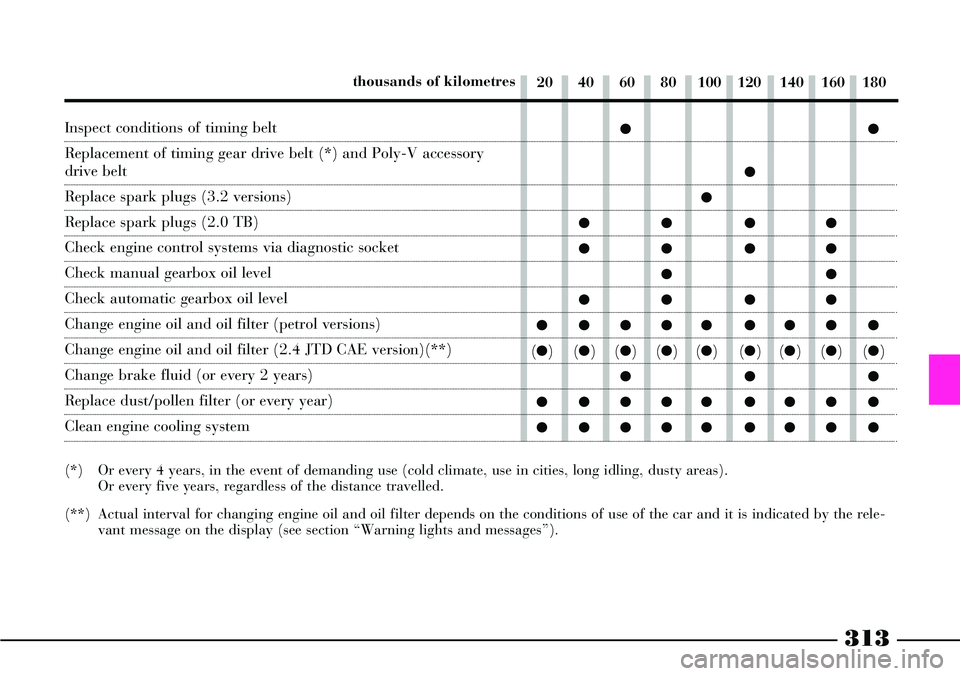
313
Inspect conditions of timing belt
Replacement of timing gear drive belt (*) and Poly-V accessory
drive belt
Replace spark plugs (3.2 versions)
Replace spark plugs (2.0 TB)
Check engine control systems via diagnostic socket
Check manual gearbox oil level
Check automatic gearbox oil level
Change engine oil and oil filter (petrol versions)
Change engine oil and oil filter (2.4 JTD CAE version)(**)
Change brake fluid (or every 2 years)
Replace dust/pollen filter (or every year)
Clean engine cooling system
(*) Or every 4 years, in the event of demanding use (cold climate, use in cities, long idling, dusty areas).
Or every five years, regardless of the distance travelled.
(**) Actual interval for changing engine oil and oil filter depends on the conditions of use of the car and it is indicated by the rele-
vant message on the display (see section “Warning lights and messages”).20 40 60 80 100 120 140 160 180 thousands of kilometres
çç
ç
ç
çç çç
çç çç
çç
çç çç
ççççç çççç
(ç)(ç)(ç)(ç)(ç)(ç)(ç)(ç)(ç)
ççç
ççççç çççç
ççççç çççç
Page 315 of 386
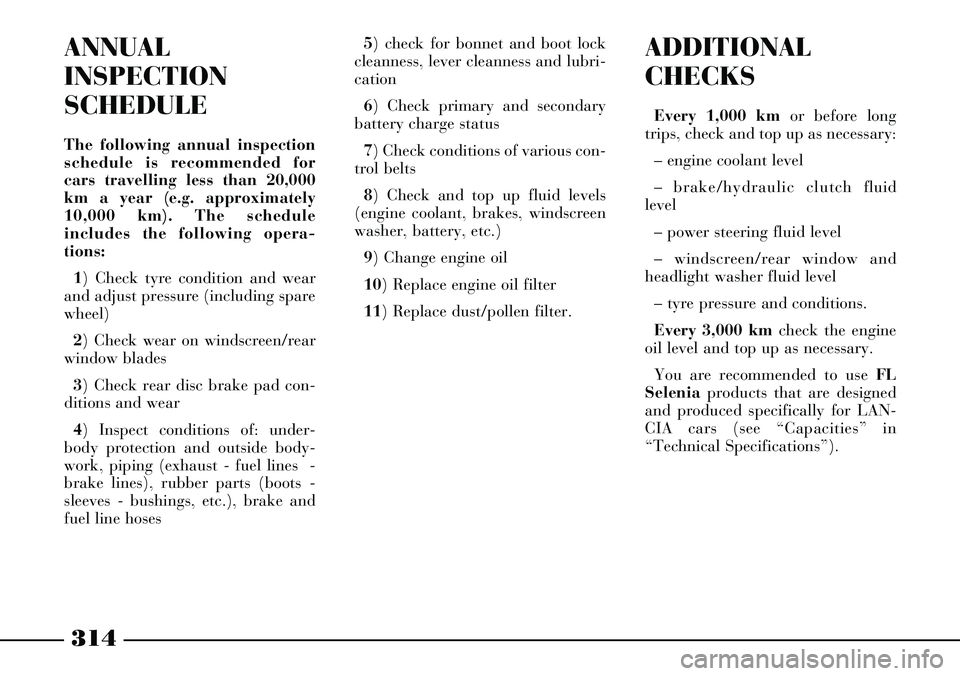
314
ADDITIONAL
CHECKS
Every 1,000 kmor before long
trips, check and top up as necessary:
– engine coolant level
– brake/hydraulic clutchfluid
level
– power steering fluid level
– windscreen/rear window and
headlight washer fluid level
– tyre pressure and conditions.
Every 3,000 kmcheck the engine
oil level and top up as necessary.
You are recommended to use FL
Seleniaproducts that are designed
and produced specifically for LAN-
CIA cars (see “Capacities” in
“Technical Specifications”).
ANNUAL
INSPECTION
SCHEDULE
The following annual inspection
schedule is recommended for
cars travelling less than 20,000
km a year (e.g. approximately
10,000 km). The schedule
includes the following opera-
tions:
1) Check tyre condition and wear
and adjust pressure (including spare
wheel)
2) Check wear on windscreen/rear
window blades
3) Check rear disc brake pad con-
ditions and wear
4) Inspect conditions of: under-
body protection and outside body-
work, piping (exhaust - fuel lines -
brake lines), rubber parts (boots -
sleeves - bushings, etc.), brake and
fuel line hoses5) check for bonnet and boot lock
cleanness, lever cleanness and lubri-
cation
6) Check primary and secondary
battery charge status
7) Check conditions of various con-
trol belts
8) Check and top up fluid levels
(engine coolant, brakes, windscreen
washer, battery, etc.)
9) Change engine oil
10) Replace engine oil filter
11) Replace dust/pollen filter.
Page 317 of 386

316
IMPORTANT - Diesel filter
The different grades of purity in
diesel fuel normally available might
make it necessary to replace the fil-
ter more frequently than indicated
in the Service Schedule. If the engine
misfires it shows the filter needs
changing.IMPORTANT - Dust/pollen filter
If the car is often used in dusty or
extremely polluted environments,
you should change the filter element
more frequently. It should be
changed especially if the amount of
air introduced into the passenger
compartment is reduced.IMPORTANT - Battery
The charge in your battery should
be checked, where possible at the
start of the winter, to limit the risk
of the battery electrolyte freezing.
This check should be carried out
more frequently if the car is mainly
used for short trips or if it is fitted
with accessories that permanently
take in electricity even when the
ignition key is removed, especially in
the case of after market accessories.
If the car is used in very hot cli-
mates or particularly demanding
conditions check the battery elec-
trolyte more frequently than shown
in the “Service Schedule” in the
“Car maintenance” chapter.